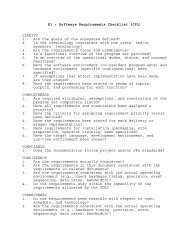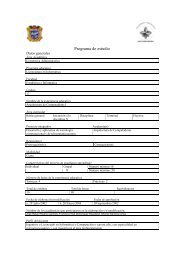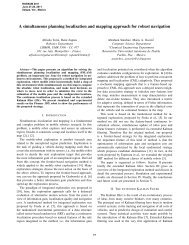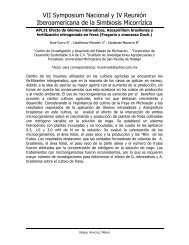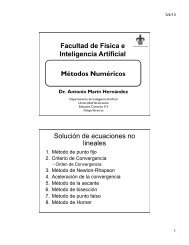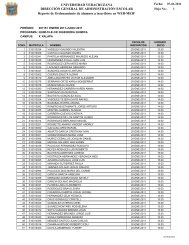Understanding the Software Options
Understanding the Software Options
Understanding the Software Options
Create successful ePaper yourself
Turn your PDF publications into a flip-book with our unique Google optimized e-Paper software.
Circle 15 on p. 54 or go to adlinks.che.com/35068-15<br />
ture is not expected to be any brighter.<br />
Process testing. Testing a process<br />
with a 5-min response time is usually<br />
easy, but testing a process with a 5-h<br />
response time is far more difficult.<br />
Properly conducting <strong>the</strong> test is crucial<br />
— this is “garbage in, garbage out”<br />
business. A poor test gives poor quality<br />
data; <strong>the</strong> model derived from <strong>the</strong>se<br />
data does not accurately represent<br />
process behavior; control logic based<br />
on this model performs poorly.<br />
Realistically, is it possible to conduct<br />
a test on a process with a 5-h response<br />
time? The answer is “yes, but with<br />
great difficulty”. Such endeavors will<br />
be undertaken only when <strong>the</strong>re is a<br />
significant incentive to do so. Commissioning<br />
MPC requires a process test to<br />
determine process behavior, which is<br />
a major component of <strong>the</strong> MPC’s total<br />
cost. The potential benefits of <strong>the</strong> process<br />
optimization made possible by<br />
MPC can easily justify <strong>the</strong> cost, but<br />
when it comes to activities such as<br />
controller tuning, anything o<strong>the</strong>r than<br />
simple tests can only be justified in<br />
those loops critical to process operations<br />
(often temperature loops where<br />
derivative is likely to be used).<br />
Dynamic modeling. The utility of<br />
steady-state models is well-estab-<br />
lished — all modern process designs<br />
are based on such models. However,<br />
<strong>the</strong> utility of dynamic models remains<br />
debatable. The technology to develop a<br />
dynamic model for any industrial process<br />
has been available for at least 20<br />
years. However, dynamic modeling is<br />
usually applied to selected parts of <strong>the</strong><br />
process (with “selected parts” sometimes<br />
being none). And even for <strong>the</strong><br />
selected parts, <strong>the</strong> dynamic modeling<br />
is not always to <strong>the</strong> detail required to<br />
tune a control loop.<br />
The practices are entirely different<br />
in <strong>the</strong> aerospace industry — detailed<br />
dynamic simulations are developed for<br />
each vehicle. Why is this not <strong>the</strong> practice<br />
in <strong>the</strong> process industries? There is<br />
a major difference in <strong>the</strong> ground rules.<br />
When an aerospace vehicle leaves <strong>the</strong><br />
ground, every loop must be in automatic<br />
and working, even on <strong>the</strong> first<br />
flight. Except for a few fast loops (one<br />
example being compressor surge control),<br />
process plants can be operated<br />
with every loop in manual. This is not<br />
a popular way to do it — more people<br />
are required and <strong>the</strong> plant does not<br />
perform as well — but something that<br />
is tolerable during startup. Basically,<br />
aerospace has to start up on automatic;<br />
process can start up on manual.<br />
Since 1968<br />
When will all process plants be simulated<br />
in detail? The day <strong>the</strong>y have to<br />
start up in automatic mode.<br />
Understand <strong>the</strong> process<br />
Senior people in process control take<br />
great delight in giving this advice to<br />
new hires. And it is true. But <strong>the</strong>re is a<br />
problem. This is strategic advice that<br />
works well at 30,000 ft and above. But<br />
exactly what does this mean to someone<br />
working at ground level, that is,<br />
someone with a specific problem to<br />
solve? New hires should not hesitate<br />
asking “exactly how do you do that?”<br />
The answer is often by examples (also<br />
called “war stories”).<br />
But understanding <strong>the</strong> process is<br />
crucial to process control. In some respects,<br />
artificial intelligence is an attempt<br />
to take a lot of data and let <strong>the</strong><br />
system make sense of it. Based on <strong>the</strong><br />
test data, MPC develops finite response<br />
models to characterize <strong>the</strong> process. But<br />
<strong>the</strong> utility of <strong>the</strong>se models depends on<br />
<strong>the</strong> quality of <strong>the</strong> test data. How does<br />
one assess <strong>the</strong> quality of <strong>the</strong>se models?<br />
One looks at how <strong>the</strong>y respond<br />
to certain changes and assesses <strong>the</strong>ir<br />
behavior in light of past experiences<br />
regarding <strong>the</strong> behavior of <strong>the</strong> process.<br />
Obviously <strong>the</strong> better one understands<br />
CHEMICAL ENGINEERING WWW.CHE.COM AUGUST 2011 37



